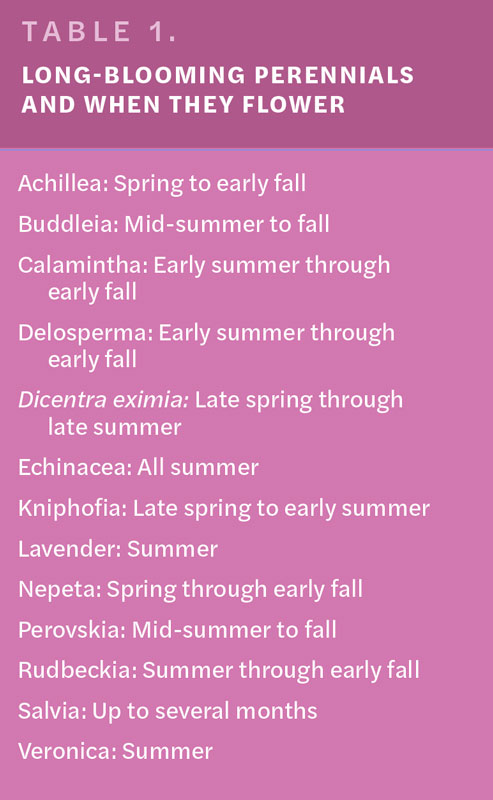6/30/2025
Tried & True Perennials
Paul Pilon

As a group of plants, perennials are diverse and can be used for many applications. Landscapers and gardeners use perennials as featured accent plants, in borders or in impressive mass plantings. From sun to shade and wet to dry, there are perennials for nearly every location and purpose.
When thinking about tried and true perennials, I think about all their uses and applications. What’s tried and true in the shade will not be so reliable in the sun and vice versa. Therefore, I keep an open mind and think about what are the most reliable plants for each situation, use and preference.
Baptisia Decadence Dark Chocolate with Sedum Rock ’N Round Superstar
Long-Blooming Perennials
There are thousands of perennials available, and although most of them are great plants in their own right, a lot of them have relatively short blooming periods. Landscapers and gardeners often look for perennials that bloom for more than a few days or a couple of weeks. Over the past couple decades, breeding efforts have increased the duration of bloom for many perennials. There are several with one month to season-long bloom times. (Check out Table 1 to see the list.)
These perennials were selected for both their long bloom times and their reliable year-after-year performance. Some of these perennials will reflush with flowers after they’re trimmed or deadheaded. Nepeta and salvia are good examples of this. There are numerous perennials, such as coreopsis, dianthus and gaillardia not listed in the table that also have extended bloom times, but may not be as long-lived as other ones listed.
Long-Lived Perennials
 Just like any living organism, some plants survive longer than others. Many perennials look great in the landscape for a few years, but slowly decline as they age. There are numerous perennials with serious staying power and easily survive for several years and even several decades.
Just like any living organism, some plants survive longer than others. Many perennials look great in the landscape for a few years, but slowly decline as they age. There are numerous perennials with serious staying power and easily survive for several years and even several decades.
As you can see in Table 2, the list is long. Most of these perennials can easily survive for years with no intervention. A couple on this listing, namely irises, would benefit from being divided every few years to ensure they survive for decades.
Asclepias tuberosa

Ensuring Longevity
Even though long-lived perennials tend to survive from a few years up to several decades, there are multiple factors that can affect staying power.
Genetics. Not all plants within these genera are created equal. There may be differences in survivability between species and even between cultivars. This is especially true with hybrids and varieties that originated from interspecific crosses.
Hardiness. Some perennials will be able to survive in colder environments better than others. Use the USDA Hardiness Zones as a guideline, but beware cold injury can still occur. Plants that have become de-acclimated in the late winter and early spring are extremely vulnerable to below-freezing temperatures, such as when an unseasonably late arctic blast moves through.
 Site. A long-lived perennial won’t live up to its expectations when it isn’t planted in the right place. Besides cold hardiness, it’s important to consider other attributes regarding a plant’s location. A full sun plant will struggle in full shade and vice versa. Some plants can tolerate a wide range of soil types and moisture contents, while others are very sensitive to saturated soils, as well as very dry ones.
Site. A long-lived perennial won’t live up to its expectations when it isn’t planted in the right place. Besides cold hardiness, it’s important to consider other attributes regarding a plant’s location. A full sun plant will struggle in full shade and vice versa. Some plants can tolerate a wide range of soil types and moisture contents, while others are very sensitive to saturated soils, as well as very dry ones.
Rudbeckia Little Goldstar
Establishment. Many perennials take a growing season or two for them to become well established. The first growing season after planting is the most important. Be sure to provide enough irrigation in the first year to help reduce plant stress and allow them to develop a good strong root system. Keep in mind that even when a plant is listed as being drought tolerant, it won’t usually be able to tolerate drought conditions until a season or two after it’s well established in the landscape.
 Rejuvenation. Some perennials, such as iris, benefit from being divided and replanted after a few years. This rejuvenates them, keeps them growing strongly and allows them to continue blooming profusely.
Rejuvenation. Some perennials, such as iris, benefit from being divided and replanted after a few years. This rejuvenates them, keeps them growing strongly and allows them to continue blooming profusely.
Salvia Back to the Fuchsia
Success with tried and true perennials takes more than simply choosing the right plant; it involves placing the plant in the right location (site, hardiness zone, soil type and moisture levels) and taking steps to help the plant become established. When the plant, site and proper cultural requirements are all aligned, these long-lived perennials will survive for many, many years and possibly for decades. GP
Table 2. Reliable Long-Lived Perennials
|
Achillea
Aconitum
Amsonia
Asclepias
Aruncus
Astilbe
Baptisia
Bergenia
Calamagrostis
Campsis radicans
Cimicifuga
Convallaria
Dicentra
Dictamnus
Echinacea
Eupatorium
|
Euphorbia
Ferns (various)
Geranium
Helenium
Helianthus
Helleborus
Hemerocallis
Hibiscus
Hosta
Iris germanica
Iris siberica
Kniphofia
Liatris
Liriope
Miscanthus
Monarda
|
Nepeta
Paeonia
Papaver orientale
Panicum
Platycodon
Polygonatum
Pycnanthemum virginianum
Rudbeckia
Salvia
Sedum
Symphyotrichum novae-angliae
Tricyrtis
Trillium
Vernonia
|